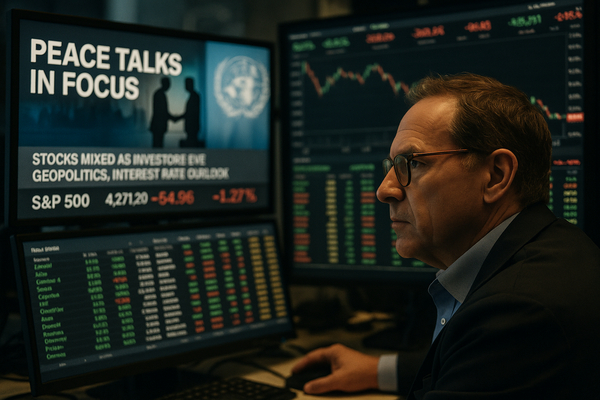
U.S. and Ukraine draft a refined peace plan that could ease war risk and reshape investor sentiment in the near term while leaving longer term geopolitical uncertainty intact. The talks matter now because an agreed framework would reduce immediate risk premia in energy and defence stocks. In the short term traders are pricing in a calmer risk tone driven by peace diplomacy, Fed rate cut bets and big corporate linkages. In the long term markets will still weigh supply risks, fiscal policy choices in Europe and the durability of global trade ties. The implications are global for U.S., European and Asian stocks and for emerging market currencies, and local for energy, defence and miners listed in London and New York.
Geopolitics and market risk
Peace talks and flare ups are rebalancing risk appetite
Negotiations between the United States and Ukraine on a revised peace plan are the most immediate geopolitical driver for markets. The talks matter now because any credible progress can reduce short term risk premia on energy and defence names, and can ease volatility across fixed income and currencies. That dynamic changes the pricing of risk assets in the United States and Europe in hours not months. However the persistent reality of contested fronts and episodic strikes means investors cannot assume a new era of stability.
Meanwhile news of an Israeli strike that killed a Hezbollah commander and repeated Russian drone attacks over Ukraine keep geopolitical volatility close to markets. Those events can push safe havens higher and raise oil and gas price sensitivity. Equity traders will watch headline risk and flows into defensive sectors on the open. Traders will also watch how commodity markets respond to any concrete signs of de-escalation because that will influence miners and energy producers across London and New York trading sessions.
Central bank outlook and interest rate pricing
Fed rate cut bets are reweighting portfolio decisions
Markets are now pricing an increased chance of Federal Reserve easing later in the year. That bet is driving shorter dated Treasury yields and changing forward curves. The timing matters now because it alters equity valuation multiples and relieves immediate pressure on rates sensitive sectors. Lower bond yields tend to support higher equity valuations in the short term, but they also force investors to reassess earnings prospects across regions.
In Europe the debate on productivity and fiscal policy is front and center. British hopes that AI can boost growth sit against the prospect of tax hikes from Finance Minister Rachel Reeves. That contrast will shape gilt demand and Sterling moves in the coming sessions. Currency desks will watch whether U.S. rate repricing leads to a weaker dollar and greater appetite for risk assets in emerging markets.
Corporate movers and sector impacts
Drug trial setbacks and mining shakeups are redirecting sector flows
Sector rotations will be driven by company news that arrived ahead of the open. Novo Nordisk (NYSE:NVO) reported that an older oral version of its semaglutide failed to meet the main goal in a late stage Alzheimer trial. The shares fell sharply and that will weigh on European healthcare names at the open. Investors will parse trial details for implications on future pipeline risk and on the biotech index more widely.
In mining, BHP (LON:BHP) abandoned an effort to buy Anglo American (LON:AAL), while Anglo and Teck Resources (NYSE:TECK) moved toward a potential $60 billion tie up. Those developments matter now because they influence copper supply narratives that underpin industrial metals pricing. The outcome will shape capital allocation for large cap miners and the direction of benchmark commodity futures, which in turn affects currencies for commodity reliant economies.
Retail and consumer faces fresh tests this holiday season. Shein’s move into a flagship Paris store has heightened political pushback against fast fashion and put pressure on department stores already coping with e-commerce competition. U.S. consumers are expected to shop in record numbers for Black Friday, but tariff related price pressure means bargains may be fewer. That will influence consumer discretionary earnings and retail stocks when U.S. exchanges open.
Europe policy, tax rules and investor implications
Wealth taxes, trade deals and COP corporate engagement reshape capital flows
Norway’s beefed up wealth tax and the exodus of high net worth individuals highlight a policy trade off that matters to asset managers and high yield strategies. The Norwegian model shows how taxing wealth can support equality but can also change domiciles for capital. That debate is relevant now for jurisdictions from Britain to Italy that are considering similar moves because capital mobility reacts faster than policy cycles.
On trade policy, European ministers are urging U.S. officials to apply more of the July EU U.S. deal, including lower tariffs on steel and removal of duties on wine and spirits. Progress on trade measures matters now because it can ease cost pressures for manufacturers and boost exporters into the U.S. market. Corporates attending the recent COP30 summit included a high representation from Fortune 100 companies. That shows corporate engagement on climate continues even when governments take varied stances on global climate diplomacy.
Traders will open the session watching headlines on the peace talks, Fed commentary and company specific moves from healthcare and miners. Bond traders will adjust positioning to the evolving rate narrative, while equity desks will reprice sector exposures for defensive and cyclically sensitive names. Volatility will be headline led, and liquidity will follow where policy and corporate news create clearer near term signals.












